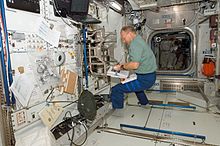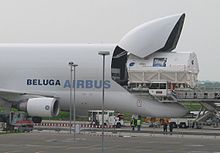Columbus (ISS module)
| Columbus | ||||||||||||||||||||||
|---|---|---|---|---|---|---|---|---|---|---|---|---|---|---|---|---|---|---|---|---|---|---|
 Columbus at the ISS captured by STS-127
|
||||||||||||||||||||||
| Space station: | International space station | |||||||||||||||||||||
| Start date: | February 7, 2008 | |||||||||||||||||||||
| Launcher: | Space Shuttle Atlantis | |||||||||||||||||||||
| Coupling: | February 11, 2008 | |||||||||||||||||||||
| Dimensions: | 10,275 kg | |||||||||||||||||||||
| Length: | 6.87 m | |||||||||||||||||||||
| Diameter: | 4.47 m | |||||||||||||||||||||
| Volume: | 75 m³ | |||||||||||||||||||||
| Adjacent modules | ||||||||||||||||||||||
|
||||||||||||||||||||||
The Columbus space laboratory is a science laboratory of the International Space Station (ISS) and the largest contribution of the European Space Agency (ESA) to the station.
The main contractor for Columbus was EADS Astrium Space Transportation in Bremen, where the final expansion took place. The supporting structure, based on the design of the MPLM supply module , comes from Alenia Spazio in Italy. In total, ESA invested around 1.4 billion euros in the laboratory.
Columbus was brought to the space station on the space shuttle Atlantis as part of the STS-122 mission and docked there on February 11, 2008.
construction
Columbus is a cylindrical module that was transported to the ISS on the Space Shuttle Atlantis and installed on February 11, 2008 on the starboard side of the Harmony connection node . The hatch is at one end of the cylinder, most of the on-board computers at the starboard end. Columbus is smaller than the other laboratory modules of the space station (the American Destiny and the Japanese Kibō PM ).
The module contains sixteen so-called International Standard Payload Racks (ISPRs). Ten of them are for scientific equipment, with four on the front, four on the back, and two on the ceiling. Three other ISPRs contain life support and cooling systems. The remaining three racks serve as storage space for experiments. Four additional payload modules can be attached externally.
The following ISPRs are installed in Columbus:
- Biolab (BLB)
- European Drawer Rack (EDR)
- European Physiology Modules (EPM)
- European Transport Carrier (ETC)
- Fluid Science Laboratory (FSL)
- Material Science Laboratory - Electromagnetic Levitator (MSL-EML)
- Microgravity Science Glovebox (MSG)
External payloads (integration in orbit):
- Atomic Clock Ensemble in Space (ACES)
- European Technology Exposure Facility (EuTEF)
- Solar Monitoring Observatory (SMO / SOLAR)
Specifications
- Length: 6.871 m
- Outer diameter: 4.477 m (including a micrometeorite protective shield 13 cm thick made of several layers of aluminum and Kevlar or Nextel (ceramic textile fabric))
- Inner diameter: 4.215 m
- Room volume: 75 m³
- Weight without payloads: 10,275 kg (initial configuration)
- Space volume of the payload racks: 25 m³
- "Walkable" room volume: 25 m³
- Maximum mass of the payload racks: 9,000 kg
- Payload Racks: 16 with a weight of up to 500 kg per rack
- Electrical power from the ISS: 20 kW (including 13.5 kW for experiments)
The specified take-off weight is 12,775 kg including a 2,500 kg payload. The maximum specified on-orbit mass is 21,000 kg including 10,160 kg payload; The payload is mostly inside the module, the other part on the External Payload Facility (working name during development: "flower boxes").
history

The Columbus program was approved by ESA in 1985. It contained three flight configurations: a free-flying experimental platform (MTFF = Man Tented Free Flyer ), which was to dock to the station for reconfiguration and maintenance, an attached pressurized module (APM) and a platform on a polar orbit (PPF). At the beginning of the studies, a service vehicle was also examined, which was supposed to be used to transport astronauts between the station and the MTFF.
In order to minimize costs, the same parts (computer, printing cylinder, etc.) were built into all flight configurations as far as possible; To reduce the cost of spare parts during the operational phase, many devices that work closely with NASA systems (intercom, video) were provided as common items .
Because of the high costs for the development and delivery of the three flight configurations and their ground equipment in the MBB-ERNO offer in 1989 (the costs formally declared in the offer exceeded the costs previously only estimated by studies by more than 50%) and political discussions continued only the APM left, renamed Columbus ; the polar platform was handled as a separate contract. In addition, ESA reduced the commonality with NASA devices in order to encourage more European developments. As a result, development costs increased and the possibility of identical spare parts for the entire station was reduced.
Due to Italian and French interventions, a new company, Eurocolumbus , was founded in 1994 with representatives from DASA, Alenia and Matra with headquarters in Bremen and a subsidiary in Turin. It soon became apparent that this management structure was not viable, and so the classic concept with a main contractor (EADS Astrium in Bremen with 41 companies from 14 countries) was reintroduced as early as 1995. The responsibility for the overall Columbus system was shared between Italy (Alenia) and Germany (DASA) according to the PICA principle. It was later found that this division negatively affected both the schedule and the cost of the program.
The official order from ESA took place on March 28, 1996. A fixed price including test equipment was agreed upon as 880 million euros.
As the interest in external experimental facilities grew, ESA initiated a major change during the ongoing development, namely the implementation of the External Payload Facility EPF.
Project management
The so-called PICA principle ( P re- I ntegrated C OF A PM COF stands for "COF" APM for "Attached Pressurized Module") defines the pitch of the technical responsibility for the system design and verification of the European space laboratory Columbus between the main contractor DASA and Alenia .
This is a special case as the main contractor for a space program is usually responsible for the entire system (like MBB - ERNO for Spacelab ).
DASA / EADS was responsible for the overall design and verification , data processing (including software), communication, electrical power supply , safety / reliability and payload integration.
Alenia was responsible for the configuration design (including ergonomics ), mechanical system design, heat management, life support system , lighting and wiring.
Alenia's system responsibility also included the pre-integration of the flight model up to the installation of the cabling in Turin and the delivery of the PICA to Bremen for completion by the main contractor DASA.
Problems
In order to regulate the complex, complementary responsibilities, extensive specifications and ICDs (Interface Control Documents) were necessary. Problems that occurred often related to the area of responsibility of the other company (e.g. necessary changes to the cabling at Alenia due to changes in the power supply by the DASA) and required lengthy negotiations to find a solution in order to keep the impact on the respective fixed price contracts to a minimum.
This division of responsibility at the system level resulted in estimated additional costs of up to 25%.
begin
On May 2, 2006, the Columbus module was officially handed over to ESA. On May 27, the module was loaded into an Airbus Beluga at Bremen Airport and began its multi-day transport to the American Kennedy Space Center (KSC) the following day . Due to the short range of this aircraft, stopovers were made in Edinburgh , Iceland , Greenland , Canada and finally in the US state of New York . The module arrived at the KSC on May 30, 2006.
The Columbus module was brought to the ISS on the US space shuttle Atlantis as part of flight STS-122, which took off on February 7, 2008. On February 11, 2008 at 22:44 (CET), the module was successful, lasting for a 7h 58min spacewalk astronauts Stanley Love and Rex Walheim , docked with the ISS.
A sensible operation of Columbus was initially not possible, as the limited crew of the ISS was largely busy with maintenance work. With the start of ISS Expedition 20 on May 29, 2009, the crew was increased from three to six people, so that regular research operations can now take place.
Columbus control center
The Columbus Control Center (Col-CC) was built on the premises of the Space Control Center of the German Aerospace Center in Oberpfaffenhofen , Bavaria .
The most important functions of the control center are the management and control of the Columbus laboratory systems as well as the provision and operation of the European ground communication network.
Ground control is carried out by engineers who, divided according to responsibilities, can support the crew in all experiments or system operations. The actual Flight Control Team (FCT) in the control room K4 works in three 8-hour shifts seven days a week. The FCT receives support from partly external teams such as the Engineering Support Team (EST) or the Ground Control Team (GCT) responsible for the infrastructure of the ground segment.
Distribution of tasks in the control room K4 of the Col-CC:
| position | Callsign | responsibility |
|---|---|---|
| Flight director | COL FD | Team leader, responsible u. a. for working with the ISS teams in Houston and Moscow |
| STRATOS (formerly Systems Engineer (SYS) & Data Management System (DMS)) | STRATOS | responsible for all subsystems in Columbus (life support, data management, communication, power supply, thermal balance) |
| COMET | COMET | responsible for real-time planning and coordination of all activities in the Columbus module |
| COSMO | COSMO | responsible for the coordination of the maintenance tasks as well as the storage space |
| EUROCOM | EUROCOM | responsible for verbal communication with the ESA astronauts |
The call sign of the control center in Oberpfaffenhofen is MUNICH (see also HOUSTON and MOSCOW ).
literature
- Dirk Lorenzen : Columbus space laboratory: Life and research on the International Space Station. Franckh-Kosmos, Stuttgart 2008, ISBN 978-3-440-11711-8
Web links
- German Aerospace Center : The European Columbus research laboratory
- German Aerospace Center: Blog about the launch and installation of Columbus
- Columbus Development History (PDF; 699 kB; English)






